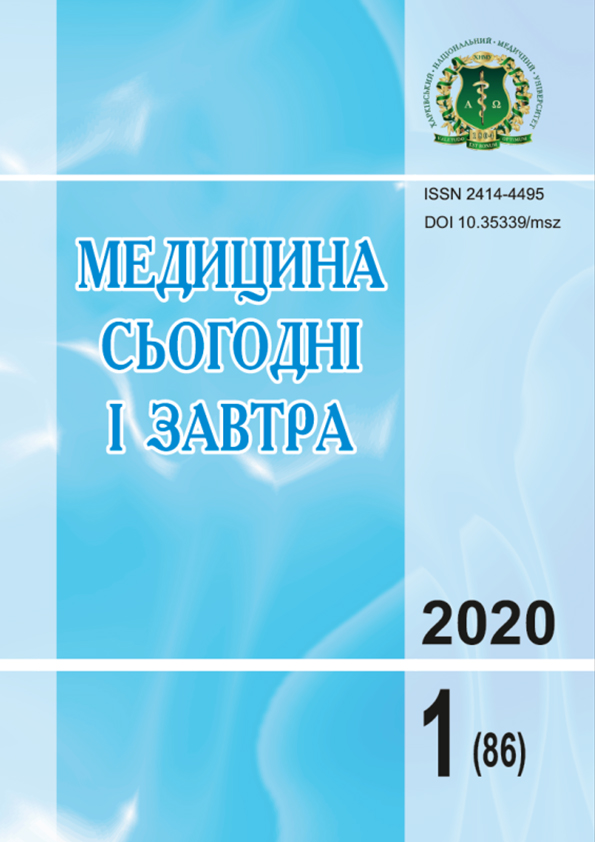Abstract
The state of circulatory energy in blood loss has been studied in 44 patients with spleen injury. Kinetic (final diastolic and systolic volumes of the left ventricle, heart rate), dynamic (effective arterial and central venous pressure, total peripheral resistance), hemic (oxygen content in arterial and venous blood) parameters of blood circulation, as well as the level of lactate reflecting the degree of hypoxia were studied. The energy indicators of blood circulation were determined: the power consumed by tissues, the oxygen reserve (reflecting the correspondence of the oxygen consumed by tissues to their needs) and the integral energy indicator - circulatory reserve. It has been determined that with an increase in blood loss, the energy indicators of blood circulation decrease: the power consumed by tissues decrease to (48.0±6.1); (41.1±8.7) and (23.5±9.3) mW/m2, the oxygen reserve decrease to (0.43±0.04); (0.37±0.05) and(0.27+0.07), the circulatory reserve decrease to (229+93); (180±41) and (47±25) mW/m2 respectively at blood loss 20 %, 30 % and 40 % of blood volume. Apparently 20 % blood loss is the maximum amount of blood loss in relation to compensatory possibilities of autoregulation of blood circulation. 30 % blood loss causes more strain on the compensatory mechanisms, at 40 % blood loss the possibility of autoregulation is exhausted. All patients with blood loss up to 20 and up to 30 % of the blood volume survived in the future, with 40 % blood loss 30 % of patients could not be saved. In all deceased patients the circulatory reserve was below 50 mW/m2. It has been determined that a decrease in the circulatory reserve to 100 mW/m2 or lower is a serious threat to life and requires great intensive therapy for blood loss, the level of the circulatory reserve of 50 mW/m2 is not compatible with life, that is, it corresponds to irreversible hemorrhagic shock.
Keywords: blood loss, hypovolemia, circulatory energy, blood flow power, oxygen reserve, circulatory reserve.
References
Ivanov, К. Р. (2016). Novyie biolohicheskie problemy v enerhetike zhivykh sistem [New biological problems in the energetics of living systems], Uspekhi sovremennoi biolohii - Advances in Modern Biology, 136(6), 586-592 [in Russian].
Usenko, L. V., Shifrin, G. A. (2007). Intensivnaia terapiia pri krovopotere [Intensive therapy for blood loss]. (3d ed.). Dnepropetrovsk: Novaia ideolohiia, 290 p. [in Russian].
Folkow, B., Neil, E. (1967). Krovoobrashcheniie [Circulation]. (Trans, from Engl.). Moscow: Meditsina, 463 p. [in Russian].
Mikhnevich, K. G. (2018). Nekotoryie voprosy hidrodinamiki і enerhetiki tsirkuliatomoho і hemicheskoho zveniiev sistemy transporta kisloroda (chast 1) [Some issues of hydrodynamics and energetics of the circulatory and hemic links of the oxygen transport system (part 1)]. Meditsina neotlozhnykh sostoianii — Emergency Medicine, 4 (91), 24—31. DOI: 10.22141/2224-0586.4.91.2018.137851 [in Russian].
Riabov, H. A. (1988). Hipoksiia kriticheskikh sostoianii [Critical hypoxia]. Moscow: Meditsina, 288 p. [in Russian].
Mykhnevych, K. G., Volkova, Yu. V, Khartanovich, M. V, Lizohub, M. V. (2020). Enerhetychni aspekty krovoobihu [Energy aspects of blood circulation]. Kharkiv: Planeta-Print, 165 p. [in Ukrainian].
Mikhnevich, K. G., Volkova, Yu. V, Baranova, N. V, Boiko, Ye. V (2020). Opredeleniie referentnykh znachenii enerheticheskikh pokazatelei krovoobrashcheniia [Determination of reference values of energy parameters of circulation], Ukrainskyi zhurnal medytsyny, biolohii ta sportu — Ukrainian Journal of Medicine, Biology and Sports, 5, 4 (26), 182-188. DOI: 10.26693/jmbs05.04.182 [in Russian].

